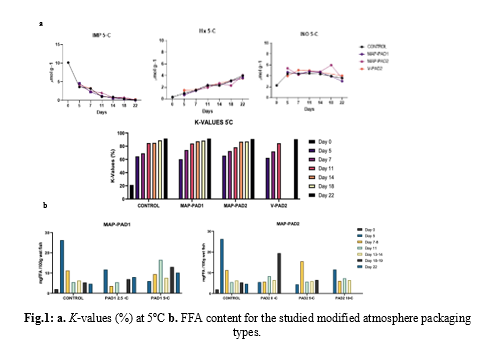VARIOUS MODIFIED ATMOSPHERE PACKAGING (MAP) CONDITIONS EFFECTS ON CHEMICAL SHELF-LIFE OF EUROPEAN SEA BASS
Introduction
European sea bass (Dicentrarchus labrax) is an important marine species with major importance in the Mediterranean mariculture. Gutted sea bass is a value-added product that exhibits increasing demand in the international seafood market. Nevertheless, fresh seafood products are highly perishable and their quality deterioration could be a result of microbial activity, chemical oxidation, or autolysis. Storage temperature and packaging atmosphere influence microbial growth and thus the shelf-life of seafood (Odeyemi et al., 2018). Modified Atmosphere Packaging (MAP) can effectively alter the spoilage process and extend the shelf life of fresh fishery products (Tsironi and Taoukis, 2018).
It is based on altering the composition of gases in contact with food by replacing the air in a sealed food package with strictly controlled gaseous mixtures, containing oxygen (O2), carbon dioxide (CO2), and nitrogen (N2), or others. Their concentrations in the package headspace depend on the specific fish product and the mechanism of spoilage that limits the shelf life of the final food product (Tsironi and Taoukis, 2018).
The objective of this study is the evaluation of the active modified atmosphere packaging on the freshness and shelf life of gutted sea bass.
Materials and methods
Fresh gutted sea bass (weight: 400-600 g) was obtained in ice by a Greek aquaculture company (Selonda S.A.). Samples were transported to the Laboratory of Food Chemistry and Technology (School of Chemical Engineering, NTUA) and packed in high-density polyethylene pouches in modified atmosphere consisted of 50% CO2-50% air with two different CO2 emitters (PAD1 dimensions 300 mm × 130 mm × 40 mm and PAD2 dimensions 366 mm × 127 mm × 50 mm) (McAirlaid’s Inc., Steinfurt, Germany) and under vacuum (V-PAD2) were used in order to evaluate the effect of active MAP on shelf-life extension. Samples were stored at controlled isothermal conditions (0, 2.5, 5 and 10 ̊C) in high precision incubators for 22 days. These samples were transported to the Sensory lab of HCMR for chemical freshness analysis.
Freshness assessment of the sea bass was based on ATP breakdown products analysis (K-values freshness index) and on free fatty acids (FFA) content. Extraction of ATP breakdown products took place from the dorsal muscle. The extraction of ATP-breakdown products and the HPLC K-values analysis has been previously described (Grigorakis et al., 2004)
A method for FFA detection was developed. FFA were extracted according to Bligh and Dyer (1959), separated using a NH2 SPE cartridge and esterified. The organic phase was then analyzed using gas chromatography-mass spectrometry (Agilent Technologies, Santa Clara, CA, USA). An extract aliquot of 1 μl was injected into the GC/MS in a split mode (1:25) and separation was achieved on an Agilent DB-23 capillary column (60 m 0.25 mm, coated with a 0.25 μm film thickness).
Identification of fatty acids was carried out by comparing the retention times with the FAME standards. Nonanoic acid methyl ester was used as an internal standard to quantify the contents of the fatty acid methyl ester assuming the detector response to each fatty acid was identical. The content of each fatty acid was expressed as mg/100g of wet matter.
Results & Discussion
The K-values for 5ºC increased from the initial 20% on day 0 to reach 90%, respectively, on the 22th day of storage in all conditions. The acceptability limit of 60% K-value corresponding to the sensory shelf life of aerobically stored fresh sea bass (Grigorakis et al., 2004) was herein reached very early, in 5th day.
ATP, ADP, and AMP remained at low concentrations throughout the storage, while IMP, Ino, and Hx exhibited some differences in their patterns. The FFA contents fluctuated throughout storage without a specific pattern (Fig. 1). FFA are the main substrates for lipid oxidation and play an important role in the flavor formation of fish products.
Acknowledgements
This research was funded by the Greek Operational Programme for Fisheries, Priority Axis “Innovation in Aquaculture”, Project title: “Application of smart and intelligent packaging for fish and development of a novel quality management and assurance tool for improved quality and extended shelf life” (2019- 2022) website: smartfish.chemeng.ntua.gr
References
Tsironi T., Taoukis P. (2018). Current practice and innovations in fish packaging. Journal of Aquatic Food Product Technology, 27, 1024-1047.
Grigorakis K, Alexis M, Gialamas I, Nikolopoulou D. 2004. Sensory, Microbiological, and Chemical Spoilage of Cultured Common Sea Bass (Dicentrarchus Labrax) Stored in Ice: A Seasonal Differentiation. European Food Research and Technology. 219: 584-87.
Odeyemi O.A, Burke C.M, Bolch C.C.J, Stanley R. (2018) Seafood spoilage microbiota and associated volatile organic compounds at different storage temperatures and packaging conditions. Int J Food Microbiol. 2; 280:87-99. doi: 10.1016/j.ijfoodmicro.2017.12.029.
